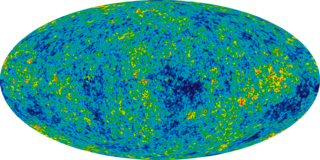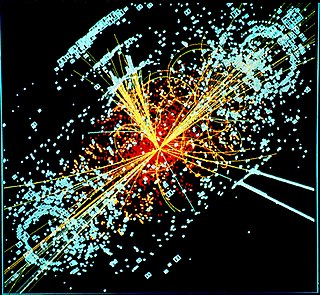Related Research Articles
Weakly interacting massive particles (WIMPs) are hypothetical particles that are one of the proposed candidates for dark matter.
An axion is a hypothetical elementary particle originally proposed by the Peccei–Quinn theory in 1977 to resolve the strong CP problem in quantum chromodynamics (QCD). If axions exist and have low mass within a specific range, they are of interest as a possible component of cold dark matter.
In physics, mirror matter, also called shadow matter or Alice matter, is a hypothetical counterpart to ordinary matter.

In particle physics, exotic baryons are a type of hadron with half-integer spin, but with a quark content different from the three quarks (qqq) present in conventional baryons. An example would be pentaquarks, consisting of four quarks and one antiquark (qqqqq̅).
The DAMA/NaI experiment investigated the presence of dark matter particles in the galactic halo by exploiting the model-independent annual modulation signature. Based on the Earth's orbit around the Sun and the solar system's speed with respect to the center of the galaxy, the Earth should be exposed to a higher flux of dark matter particles around June 1, when its orbital speed is added to the one of the solar system with respect to the galaxy and to a smaller one around December 2, when the two velocities are subtracted. The annual modulation signature is distinctive since the effect induced by dark matter particles must simultaneously satisfy many requirements.
In particle physics, the crypton is a hypothetical superheavy particle, thought to exist in a hidden sector of string theory. It has been proposed as a candidate particle to explain the dark matter content of the universe. Cryptons arising in the hidden sector of a superstring-derived flipped SU(5) GUT model have been shown to be metastable with a lifetime exceeding the age of the universe. Their slow decays may provide a source for the ultra-high-energy cosmic rays (UHECR).
An exotic star is a hypothetical compact star composed of exotic matter, and balanced against gravitational collapse by degeneracy pressure or other quantum properties.
In particle physics, the lightest supersymmetric particle (LSP) is the generic name given to the lightest of the additional hypothetical particles found in supersymmetric models. In models with R-parity conservation, the LSP is stable; in other words, it cannot decay into any Standard Model particle, since all SM particles have the opposite R-parity. There is extensive observational evidence for an additional component of the matter density in the universe, which goes under the name dark matter. The LSP of supersymmetric models is a dark matter candidate and is a weakly interacting massive particle (WIMP).
In astrophysics and particle physics, self-interacting dark matter (SIDM) is an alternative class of dark matter particles which have strong interactions, in contrast to the standard cold dark matter model (CDM). SIDM was postulated in 2000 as a solution to the core-cusp problem. In the simplest models of DM self-interactions, a Yukawa-type potential and a force carrier φ mediates between two dark matter particles. On galactic scales, DM self-interaction leads to energy and momentum exchange between DM particles. Over cosmological time scales this results in isothermal cores in the central region of dark matter haloes.
In particle physics, hexaquarks, alternatively known as sexaquarks, are a large family of hypothetical particles, each particle consisting of six quarks or antiquarks of any flavours. Six constituent quarks in any of several combinations could yield a colour charge of zero; for example a hexaquark might contain either six quarks, resembling two baryons bound together, or three quarks and three antiquarks. Once formed, dibaryons are predicted to be fairly stable by the standards of particle physics.
The chameleon is a hypothetical scalar particle that couples to matter more weakly than gravity, postulated as a dark energy candidate. Due to a non-linear self-interaction, it has a variable effective mass which is an increasing function of the ambient energy density—as a result, the range of the force mediated by the particle is predicted to be very small in regions of high density but much larger in low-density intergalactic regions: out in the cosmos chameleon models permit a range of up to several thousand parsecs. As a result of this variable mass, the hypothetical fifth force mediated by the chameleon is able to evade current constraints on equivalence principle violation derived from terrestrial experiments even if it couples to matter with a strength equal or greater than that of gravity. Although this property would allow the chameleon to drive the currently observed acceleration of the universe's expansion, it also makes it very difficult to test for experimentally.

Light dark matter, in astronomy and cosmology, are dark matter weakly interacting massive particles (WIMPS) candidates with masses less than 1 GeV. These particles are heavier than warm dark matter and hot dark matter, but are lighter than the traditional forms of cold dark matter, such as Massive Compact Halo Objects (MACHOs). The Lee-Weinberg bound limits the mass of the favored dark matter candidate, WIMPs, that interact via the weak interaction to GeV. This bound arises as follows. The lower the mass of WIMPs is, the lower the annihilation cross section, which is of the order , where m is the WIMP mass and M the mass of the Z-boson. This means that low mass WIMPs, which would be abundantly produced in the early universe, freeze out much earlier and thus at a higher temperature, than higher mass WIMPs. This leads to a higher relic WIMP density. If the mass is lower than GeV the WIMP relic density would overclose the universe.
A strangelet is a hypothetical particle consisting of a bound state of roughly equal numbers of up, down, and strange quarks. An equivalent description is that a strangelet is a small fragment of strange matter, small enough to be considered a particle. The size of an object composed of strange matter could, theoretically, range from a few femtometers across to arbitrarily large. Once the size becomes macroscopic, such an object is usually called a strange star. The term "strangelet" originates with Edward Farhi and Robert Jaffe in 1984. Strangelets can convert matter to strange matter on contact. Strangelets have been suggested as a dark matter candidate.

EDELWEISS is a dark matter search experiment located at the Modane Underground Laboratory in France. The experiment uses cryogenic detectors, measuring both the phonon and ionization signals produced by particle interactions in germanium crystals. This technique allows nuclear recoils events to be distinguished from electron recoil events.

In astrophysics and cosmology scalar field dark matter is a classical, minimally coupled, scalar field postulated to account for the inferred dark matter.
Dark radiation is a postulated type of radiation that mediates interactions of dark matter.
Fuzzy cold dark matter is a hypothetical form of cold dark matter proposed to solve the cuspy halo problem. It would consist of extremely light scalar particles with masses on the order of eV; so a Compton wavelength on the order of 1 light year. Fuzzy cold dark matter halos in dwarf galaxies would manifest wave behavior on astrophysical scales, and the cusps would be avoided through the Heisenberg uncertainty principle. The wave behavior leads to interference patterns, spherical soliton cores in dark matter halo centers, and cylindrical soliton-like cores in dark matter cosmic web filaments.

The dark photon is a hypothetical hidden sector particle, proposed as a force carrier similar to the photon of electromagnetism but potentially connected to dark matter. In a minimal scenario, this new force can be introduced by extending the gauge group of the Standard Model of Particle Physics with a new abelian U(1) gauge symmetry. The corresponding new spin-1 gauge boson can then couple very weakly to electrically charged particles through kinetic mixing with the ordinary photon and could thus be detected. The dark photon can also interact with the Standard Model if some of the fermions are charged under the new abelian group. The possible charging arrangements are restricted by a number of consistency requirements such as anomaly cancellation and constraints coming from Yukawa matrices.

Glennys Reynolds Farrar is a professor of physics at New York University who specializes in particle physics, cosmology and the study of dark matter. She has made several significant contributions to the fields of hadron and dark matter phenomenology, helping to develop the working "Standard Cosmological Model". Farrar is a figure in developing many modern particle-search techniques, achieving numerous recognitions including as the Guggenheim Fellowship for Natural Sciences and Sloan Fellowship. She holds a faculty position at New York University (NYU), where she has been since 1998.
Daniel S. Akerib is an American particle physicist and astrophysicist. He was elected in 2008 a fellow of the American Physical Society (APS).
References
- ↑ Wandelt, Benjamin D; Dave, Romeel; Farrar, Glennys R; McGuire, Patrick C; Spergel, David N; Steinhardt, Paul J (2000), "Self-Interacting Dark Matter", in Cline, David B (ed.), Sources and Detection of Dark Matter and Dark Energy in the Universe, Springer-Verlag, p. 263, arXiv: astro-ph/0006344 , Bibcode:2001sddm.symp..263W, ISBN 978-3-540-41216-8
- ↑ Massey, Richard; et al. (2017), "Dark matter dynamics in Abell 3827: new data consistent with standard Cold Dark Matter", Monthly Notices of the Royal Astronomical Society, 477 (1): 669–677, arXiv: 1708.04245 , Bibcode:2018MNRAS.477..669M, doi:10.1093/mnras/sty630
- ↑ Grossman, Lisa (April 5, 2018). "Dark matter isn't interacting with itself after all". ScienceNews. Retrieved 2018-04-05.
- ↑ Chung, Daniel J. H; Farrar, Glennys R; Kolb, Edward W (1998), "Are ultrahigh energy cosmic rays signals of supersymmetry?", Physical Review D, 57 (8): 4606, arXiv: astro-ph/9707036 , Bibcode:1998PhRvD..57.4606C, doi:10.1103/PhysRevD.57.4606, S2CID 44780458
- ↑ Albuquerque, Ivone F. M; Farrar, Glennys R; Kolb, Edward W (1998), "Exotic massive hadrons and ultra-high energy cosmic rays", Physical Review D, 59 (1): 015021, arXiv: hep-ph/9805288 , Bibcode:1998PhRvD..59a5021A, doi:10.1103/PhysRevD.59.015021
- ↑ Qin, Bo; Wu, Xiang-Ping (2001), "Constraints on the Interaction between Dark Matter and Baryons from Cooling Flow Clusters", Physical Review Letters, 87 (6): 061301, arXiv: astro-ph/0106458 , Bibcode:2001PhRvL..87f1301Q, doi:10.1103/PhysRevLett.87.061301, PMID 11497819, S2CID 13510283
- ↑ Chuzhoy, Leonid; Nusser, Adi (2006), "Consequences of short range interactions between dark matter and protons in galaxy clusters", The Astrophysical Journal, 645 (2): 950–954, arXiv: astro-ph/0408184 , Bibcode:2006ApJ...645..950C, doi:10.1086/504505, S2CID 16131656
- ↑ Starkman, Glenn D; Gould, Andrew; Esmailzadeh, Rahim; Dimopoulos, Savas (1990), "Opening the window on strongly interacting dark matter", Physical Review D, 41 (12): 3594–3603, Bibcode:1990PhRvD..41.3594S, doi:10.1103/PhysRevD.41.3594, PMID 10012303
- ↑ Cyburt, Richard H; Fields, Brian D; Pavlidou, Vasiliki; Wandelt, Benjamin D (2002), "Constraining Strong Baryon-Dark Matter Interactions with Primordial Nucleosynthesis and Cosmic Rays", Physical Review D, 65 (12): 123503, arXiv: astro-ph/0203240 , Bibcode:2002PhRvD..65l3503C, doi:10.1103/PhysRevD.65.123503, S2CID 14926247 .
- ↑ Zaharijas, Gabrijela; Farrar, Glennys R (2004), "A Window in the Dark Matter Exclusion Limits", Physical Review D, 72 (8): 083502, arXiv: astro-ph/0406531 , Bibcode:2005PhRvD..72h3502Z, doi:10.1103/PhysRevD.72.083502, S2CID 39245145
- 1 2 Bacci, C.; et al. (1996), "Improved limits on strongly interacting massive particles with NaI(Tl) scintillators", Astroparticle Physics, 4 (3): 195–198, Bibcode:1996APh.....4..195B, doi:10.1016/0927-6505(95)00032-1
- ↑ McGuire, Patrick C; Steinhardt, Paul J (2001), "Cracking Open the Window for Strongly Interacting Massive Particles as the Halo Dark Matter", Proceedings of the International Cosmic Ray Conference, vol. 4, Hamburg, Germany, p. 1566, arXiv: astro-ph/0105567 , Bibcode:2001ICRC....4.1566M
{{cite book}}: CS1 maint: location missing publisher (link) - ↑ Javorsek II, D; Fischbach, E; Teplitz, V (2002), "New Experimental Bounds on the Contributions to the Cosmological Density Parameter Ω from Strongly Interacting Massive Particles", The Astrophysical Journal, 568 (1): 1–8, Bibcode:2002ApJ...568....1J, doi: 10.1086/338796
- ↑ Mitra, Saibal (2004), "Uranus's anomalously low excess heat constrains strongly interacting dark matter", Physical Review D, 70 (10): 103517, arXiv: astro-ph/0408341 , Bibcode:2004PhRvD..70j3517M, doi:10.1103/PhysRevD.70.103517, S2CID 53396770
- ↑ Mack, Gregory D; Beacom, John F; Bertone, Gianfranco (2007), "Towards Closing the Window on Strongly Interacting Dark Matter: Far-Reaching Constraints from Earth's Heat Flow", Physical Review D, 76 (4): 043523, arXiv: 0705.4298 , Bibcode:2007PhRvD..76d3523M, doi:10.1103/PhysRevD.76.043523, S2CID 119710504
